Ask Auntie Leila: Getting the house ready and warm for winter.
Dear McKenna asked a question that of course got my advice juices flowing.
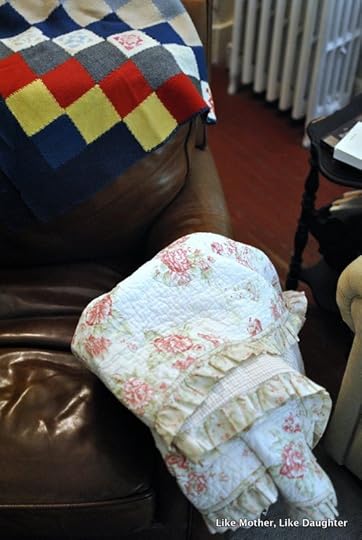
Dear Auntie Leila,
I’m hoping you can offer some wisdom on prepping the home (both house and people) for the winter months.
I’ve recently relocated to upstate New York from Austin Texas. My husband and I grew up in Michigan so we kind of know what we’ve gotten ourselves into, weather-wise. Anyway I’ll take cold over 114 degrees and rattle snakes any day. The problem is I’ve never experienced a winter while running a household or with children. My boys are 8 and 1. My parents run a very efficient household but have trouble articulating exactly what it is they do and why.
Adding to my confusion is the fact that our new home is older (1940s). It is heated with steam radiators and has all the original windows. I was able to use some of your “keeping a home cool in the summer” tips and am hoping you may have similar tips for winter.
We have steam radiators, and I hadn’t planned to install radiator covers. I’m sure we will have a few burned fingers in the beginning but am hoping the little one learns quickly. However a neighbor mentioned that steam radiators get quite a bit hotter than water ones. Should I be concerned?
When is a good time to transition window screens to storm windows? I’d like to do a thorough cleaning while I’m switching them, but what if the weather turns warm again and I miss the screens? I’m thinking late October.
I’ve heard that large coats aren’t supposed to be worn if a child is in a car seat. Assuming a little one can not yet take his coat off unassisted, do I put the coat on, walk out the door, get into the car, take his coat off, buckle him up and repeat in reverse order when getting out? Should I invest in a good quality fleece for quick trips from the house to car and only use the coat when he’s actually outside?
Finally, I’m trying to slowly acquire the outerwear we will need this year. Any tips on brands or items that are a good investment?
Thank you!
McKenna
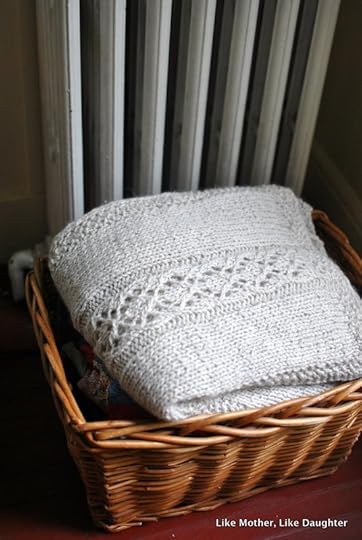
What we try to do here at Like Mother, Like Daughter is gently help you know how to “live differently” — for instance, living on one income, knowing that perhaps you, like us, do not have the bucks to spend on luxuries like cranking up the heat.
I’m well aware that readers live in different parts of the country, of course.
When I wrote about dressing properly for the cold weather, the comments had me musing on how different things can be for different people. By “cold weather” I don’t really mean in the 40s. And I don’t really mean “for the 10 seconds your child has to run through the 30-degree air.” I mean living where it’s pretty dang cold (and damp to boot, often) and I’m assuming that your children will not be climate controlled at all times, but will want to play outside pretty much regardless.
A lot depends on your circumstances. There’s no question, for instance, that schools are overheated, so it really is folly to send a child all bundled up.
Yet, it’s also folly to think that even as we collectively feel pretty guilty for using up the world’s resources this way, we seem incapable of just turning down the heat in a public building and relying on people to know how to dress.
Do you want to know how to dress? How to keep your house warm in a thrifty way?
This is the thrust of my suggestions in this post: I’m assuming that you want to know how people cope with things when the optimal conditions do not obtain.
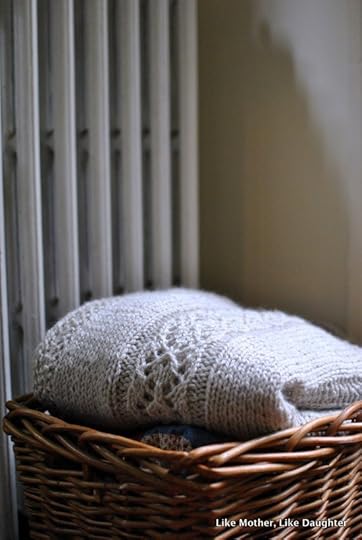
Dear McKenna,
Here is what you need to know.
You should install the storm windows now, while the weather is nice during the day. That way, it’s not a problem for you to get them out, clean them, and make the necessary repairs. It’s still warm enough for you to caulk around frames, which will really help keep things warm.
If your house is like the Chief’s parents’ house (built in the 20s), you also have screens to put away, and you want to be sure you do that in an orderly way, saving yourself grief in the spring.
The days are still not so short that you would have to rush when you are cleaning windows, and the leaves haven’t started blowing around, making things hard to clean.
You will probably find that the storm windows have a mechanism so that you can prop them open. Thus, if the weather is nice during the day, you can just do that — open them up at the bottom, pushing them out. You don’t have to really worry about screens since the bugs are gone. (You can always get a few of those little adjustable half-window screens, but a stray wasp isn’t really that big of a deal — they are too drowsy to be a problem.) Even if they don’t have this feature, you can leave off one or two on the sunny side of the house, and pop them on when things really get cold.
This way, you can set your heat at a reasonable level and enjoy having it on in the chilly nights but still open a few windows during the warm days. It can get cold! Our heat has already come on once or twice, but I have replacement windows so it didn’t take long to close them up. (By the way, the old-fashioned windows work just as well with those storms, so don’t worry — just keep them in good repair.)
The radiators probably will need covers. My MIL did have them (we have hot water heat, so no covers). You can see how it goes. Maybe our readers have tips about this form of heat, as I’m not as familiar with it.
Now, you want to notice this year how the heat flow works in your house. This is the year for figuring it out. Do you have zones? If so, you want to set your upstairs to a lower temperature than the downstairs.
The bedrooms really don’t need to be as warm as the living areas. When you have good bedding — flannel sheets, down comforters, duvet covers, wool blankets for in between the layers — you find it’s preferable to sleep in air that is not too stuffy. When the heat is high, everyone wakes up with stuffed noses and headaches, and the rooms get very dusty.
The children should wear flannel pjs with undershirts underneath.
Here is the purpose of the undershirt my dear readers: It’s so that you have a layer which you do not remove, keeping your body heat close. A child can put his undershirt in the wash before the bath. After the bath, keep it on, tucked into the underpants. The pjs get put away and the clothes go on, but never is the poor bare skin exposed to that lower temperature in the bedrooms.
That’s the old-fashioned way. Maybe today people just pay no attention to that sort of thing — I know I had to figure it out — but it’s good to remember it in case for some reason it’s much colder than you expected — for instance, when the power goes out and you aren’t able to simply check into a hotel for the duration.
Anyway, back to the house. Even if you only have one zone, you can keep the different areas warm if you have doors to shut. Your challenge is going to be keeping the warm air downstairs — of course, being warm, it wants to rise. Yes, you can go on heating the first level all day, or you can keep the heated air in place.
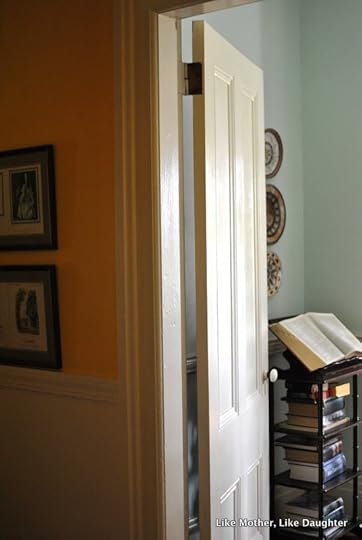
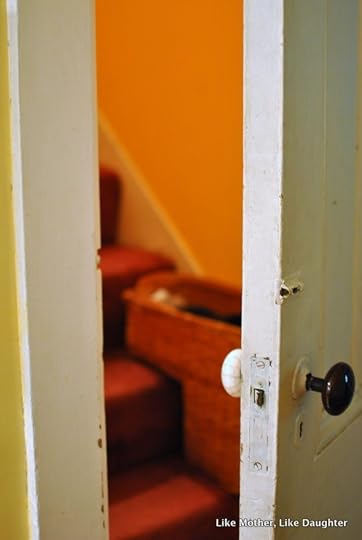
You may notice that there is one area where the heat really escapes and there isn’t a door. You can install a heavy curtain there. Just use a strong rod (or conduit bar) and nice matelessé quilts.
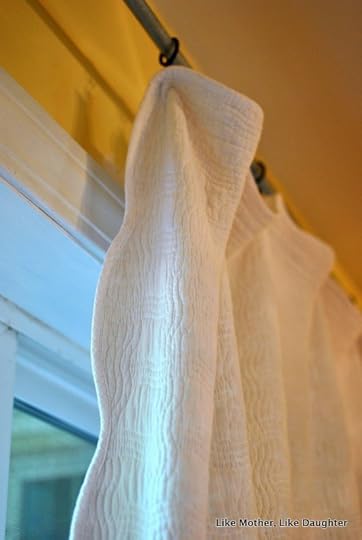
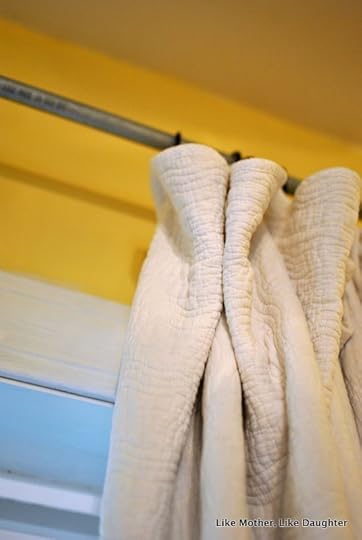
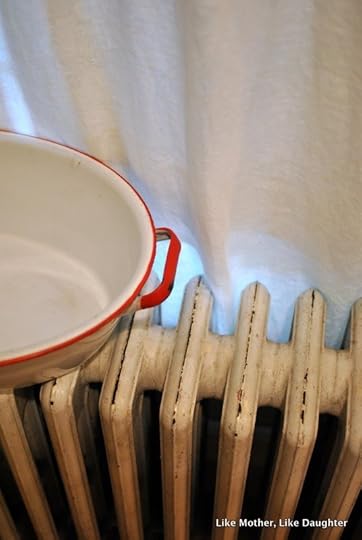
Just as in the summer you kept the strong sun out of your rooms, in the winter you want to let that sun in. A really good house is designed to take advantage of the sun’s angles in the different seasons. Mine is not, alas. I have little southern exposure. But if you have some south-facing windows, be sure to open up the curtains during the day.
Then you want to close them in the evening to keep the heat in. Investing in wooden blinds, Roman shades, and heavy curtains really helps with what are basically holes in your shelter.
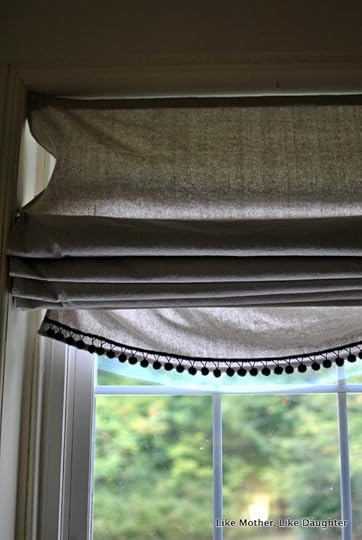
That ceiling fan that cools you off in the summer can really help move the warm air down from the top of the room — you simply reverse the direction by means of the little switch on the base.
If you have a fireplace, you can see how well it works this winter. Usually fireplaces, unless they are of the Rumford design, aren’t efficient at all. (Readers interested in learning more should check out this little book: The Forgotten Art of Building A Good Fireplace .)
.)
Depending on how it goes this year, you might want to install an efficient wood-burning stove in the fireplace. Combined with a ceiling fan and depending on how big and open your house is, you might find that you can use your heat just to keep your pipes in the basement warm, using the stove as your main source. In any case, it will definitely be an important part of just feeling warm to have a source for the heat around which you can gather — having the warm air radiate makes you feel much warmer, as long as it’s not whooshing past you, bringing cooler air in its wake. I know that my wood-burning stove in the kitchen keeps me from just falling down frozen in the middle of my day.
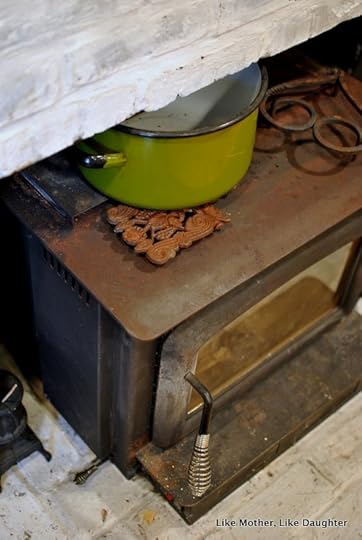
As to the children’s outerwear, let’s please all use some common sense. If it’s the middle of winter and in the single digits, you just can’t be removing a child’s coat to get in the car! Neither is a really poofy coat going to be practical for a tot. Just get a warm one that he can move around in and make sure that the straps of the carseat are secure.
Kids tend to get extremely overheated in the car, so you have to be smart. You can keep the heat lower; or if it’s on high, then yes, take the jacket off.
The one thing you really can’t do is let all the body heat escape as you are getting out, and then spend a long time outside.
Everyone needs a jacket that goes below the waist to the hips, a hat, a scarf, and mittens. Put the scarf on under the jacket, around the neck. It does no good outside the coat! That way, if the jacket has to come off, at least the chest is still warm. The jacket should have knit wrist cuffs to keep the air from going up the sleeves and to keep the mittens on securely.
One like this is perfect. And this one for a toddler.
is perfect. And this one for a toddler.
I have two whole posts on what kids need for cold weather.
The most important thing to remember is that little kids don’t need bulky sweaters. They usually hate them, won’t wear them, and get overheated in them.
No, they need layers that trap their own heat without confining them: an undershirt, a regular flannel or thick knit shirt, and if anything, a light vest or fleece pullover. Even a thin shirt if the child runs warm will work as long as there is an underwear shirt long enough to tuck in underneath. You will spare yourself the grouchy, seemingly odd breakdown parts of the day if you follow this advice, because getting your body heat back up makes you cranky!
Girls need real pants, not leggings, or corduroy skirts with good sturdy tights. Leggings are not warm enough as the only layer on the legs! And most of all, do not let their little middles be exposed to the air. Tuck that t-shirt in!
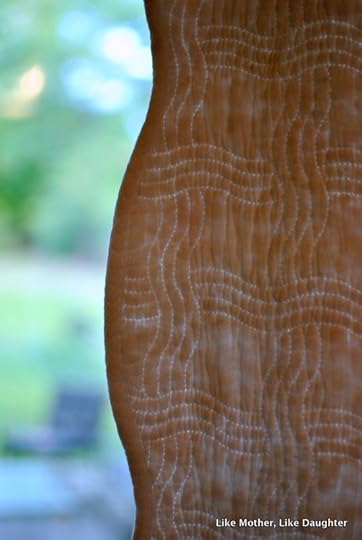
Enjoy your winter, dear McKenna! Thank you for writing!
The post Ask Auntie Leila: Getting the house ready and warm for winter. appeared first on Like Mother Like Daughter.



